Poha idli recipe with step by step pics. These are amazingly soft, light and fluffy idli varieties made with poha (parched rice), idli rice and whole urad dal (husked whole black gram). It makes for a healthy and delicious breakfast or lunch when paired with coconut chutney and sambar.
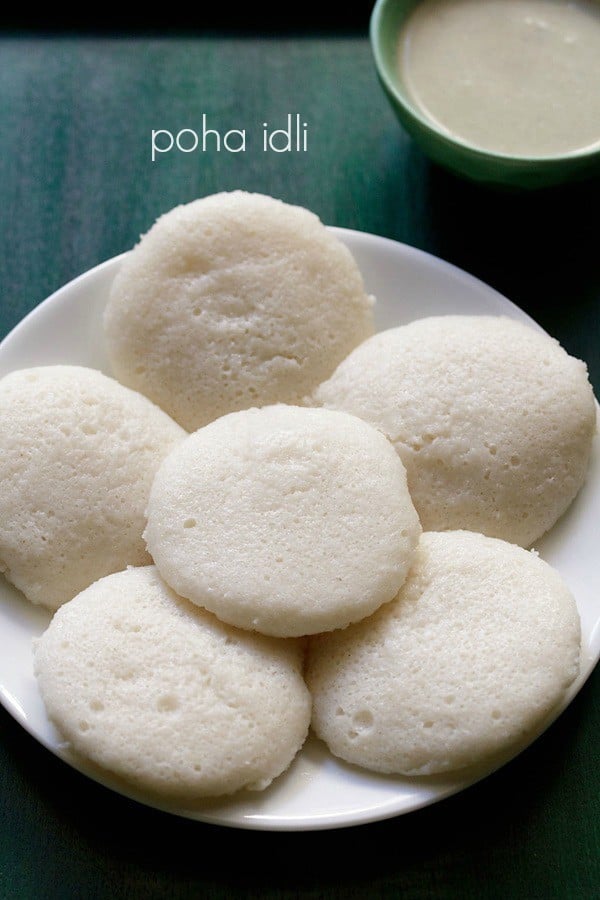
Poha is flattened rice. You can use thick or thin poha. If you do not have idli rice, then use parboiled rice or sela chawal. You can also use any regular rice like sona masuri or parimal rice. Also make sure that the urad dal is fresh and not close to its expiry date.
These poha idli has 1:1 ratio of poha and idli rice in cup measurement. The amount of urad dal added in this recipe is also less.
While making any idli batter, do remember that temperature is very crucial for proper fermentation of the batter. In cold climates, fermentation does not happen well. I get a lot of queries on the fermentation of idli batter in winters. So summarized my experiences in this Dosa Recipe.
The day I made these poha idli, the temperature in the night dropped to 16 degrees celsius and I kept the batter for around 15 hours in a warm place in my kitchen.
The South Indian snack of idlis is not only healthy but also a good breakfast to start your day. You can also pack them in the tiffin box and they stay soft even later. Idli, dosa, uttapam are one of those perfect food for me, which I can have every day and even for lunch and dinner.
These poha idli are so soft that you would love to dunk them in sambar and coconut chutney. In fact even a vegetable korma will go very well with them. I make Set dosa using a similar proportion.
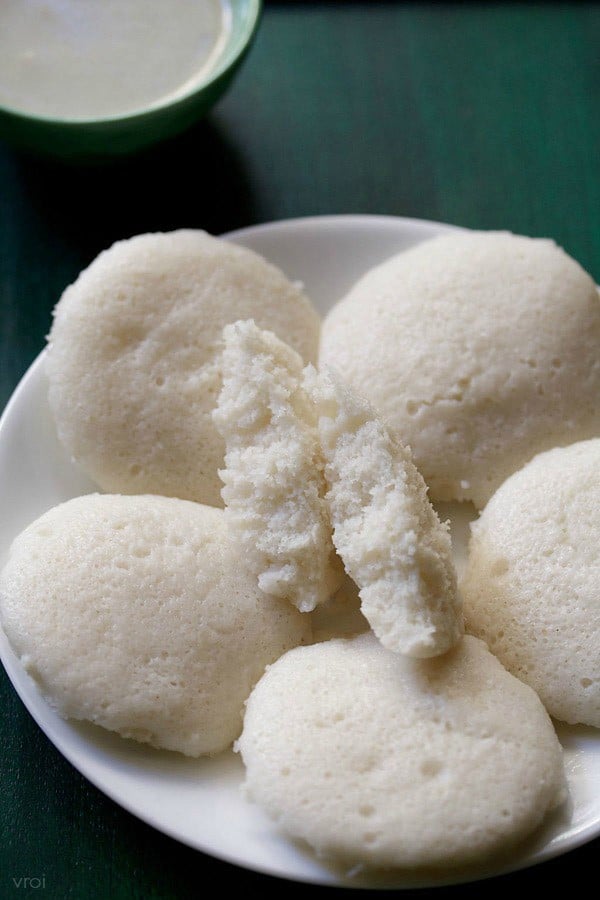
How to make Poha Idli
1. In a bowl or pan, take the following ingredients – 1 cup idli dosa rice or parboiled rice (200 grams), 3 tablespoons of whole urad dal (40 grams of husked whole black gram) and ¼ teaspoon fenugreek seeds (methi seeds). I used idli rice.
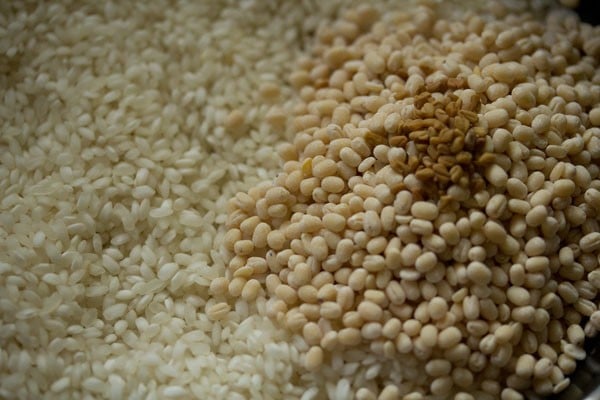
2. Rinse them for a couple of times in fresh water and then soak them in a bowl with 2.5 cups of water.
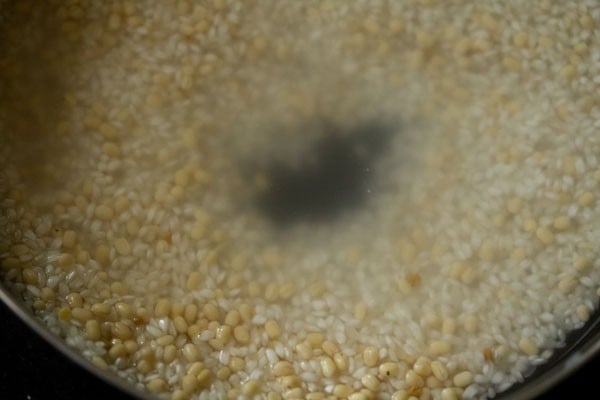
3. Next, in a separate bowl or pan, take 1 cup thick poha (80 grams).
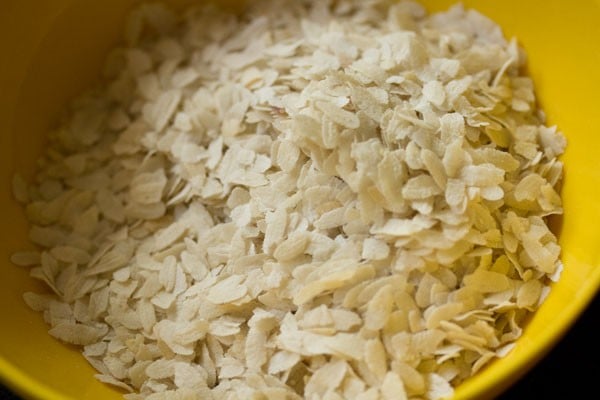
4. Rinse the poha once or twice with water.
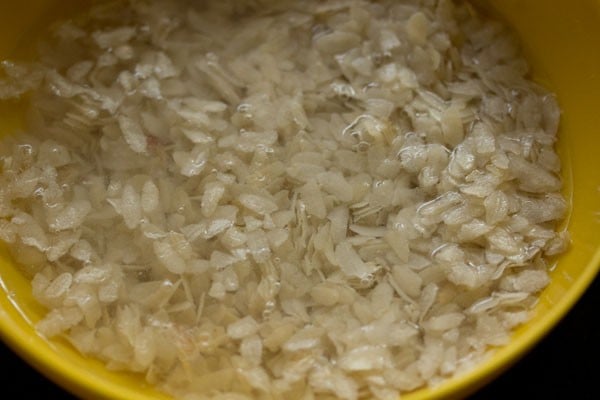
5. Strain the water and add the poha to the bowl containing rice, urad dal, methi seeds and water.
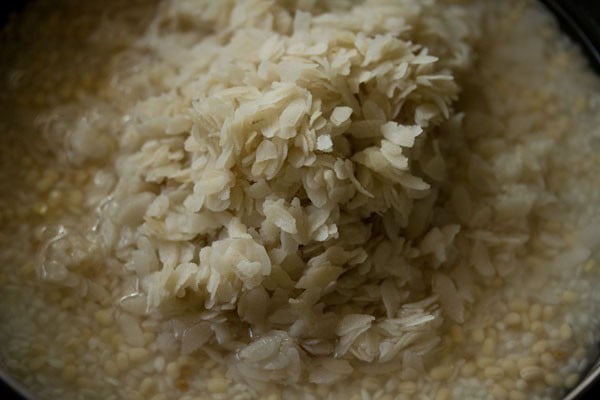
6. Mix well. Cover the pan and soak these four ingredients in water for 5 to 6 hours.
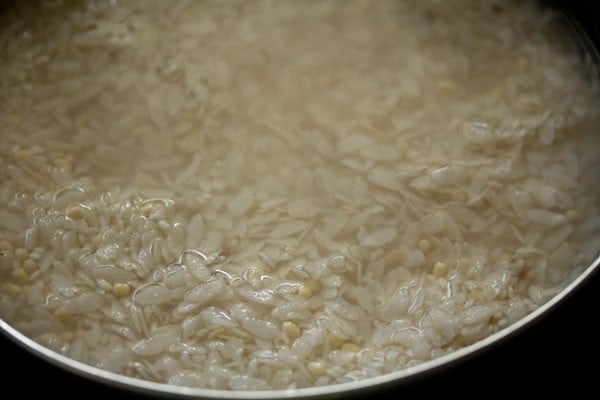
7. Later, strain very well. Reserve the strained water. We will use this strained water for grinding.
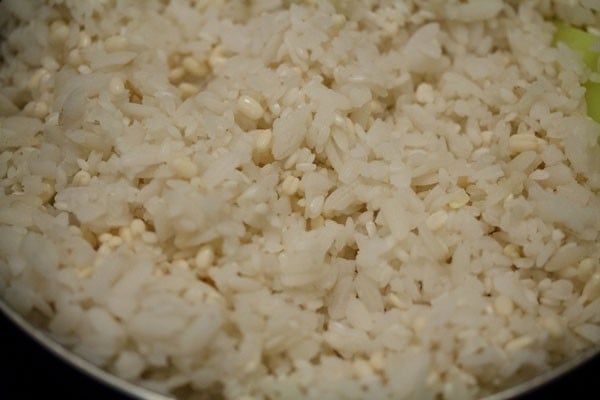
8. Now add half of the soaked ingredients in a wet grinder jar. Depending on the size of the jar, you can add half or full.
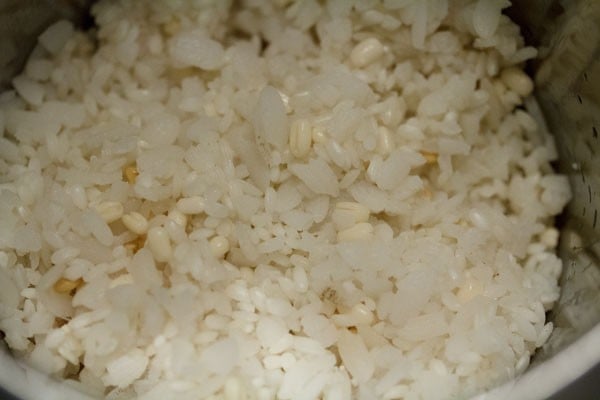
9. Add ½ cup water and grind very well. The rice grains can have a consistency of that like idli rawa.
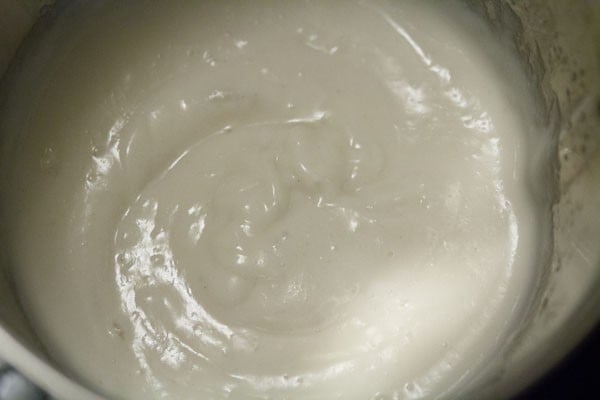
10. Now pour the batter in a large bowl.
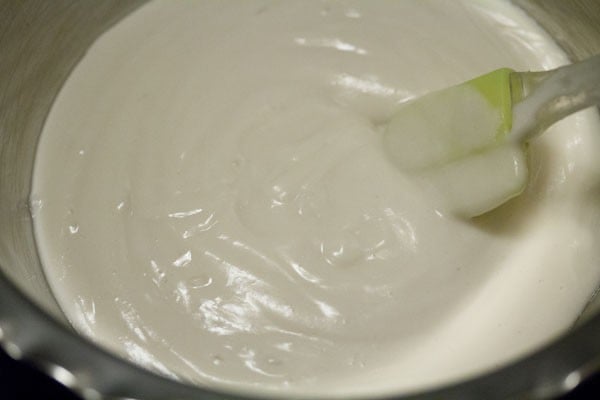
11. I ground the batter in two batches and overall used 1 cup water. If the grinder becomes hot, then wait for it to cool down and then continue with the grinding.
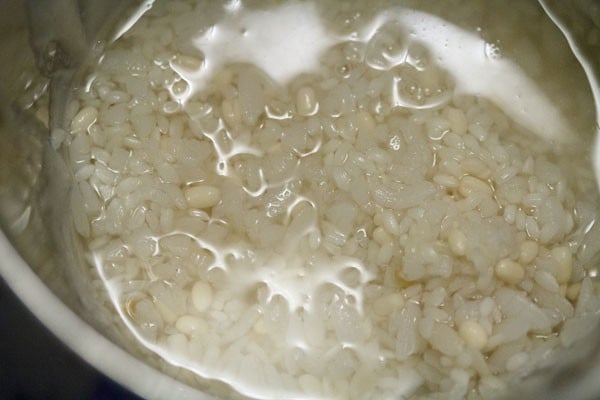
12. Add this ground batter to the bowl as well. Mix very well.
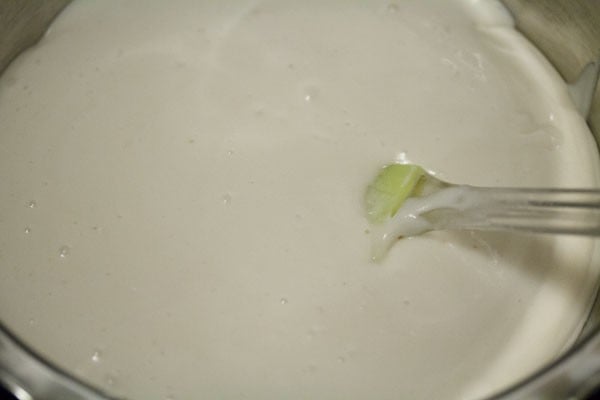
13. Then add ½ teaspoon rock salt and ½ teaspoon sugar. Don’t worry the taste of sugar is not felt in the idlis.
If you live in a hot or warm tropical climate, then no need to add sugar. Skip adding salt if the temperature is too cold in your city.
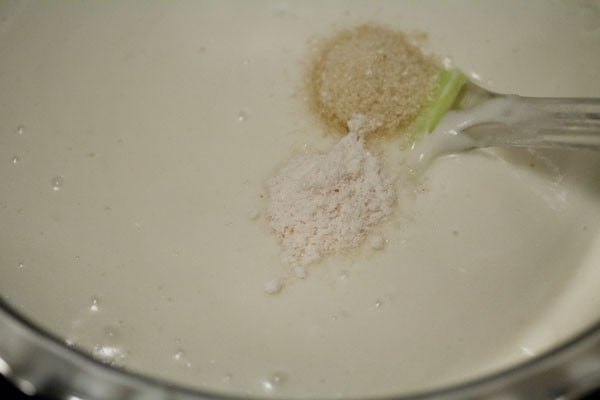
14. Mix very well.
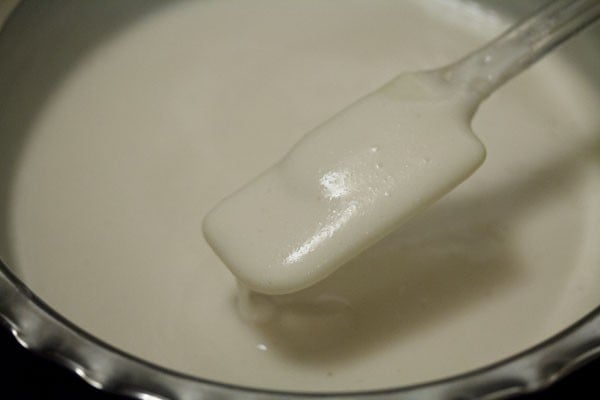
15. Cover the bowl with a lid and keep the bowl for 8 to 9 hours or more depending on the temperature conditions in your city.
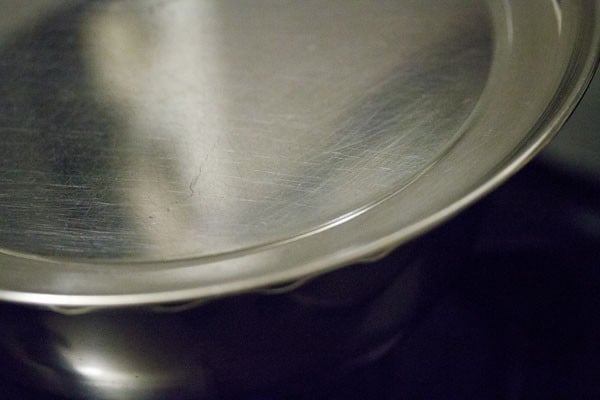
16. This is the batter, the next day.
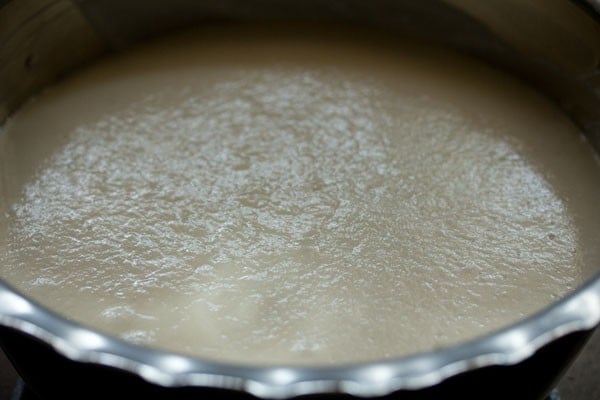
17. Add ⅛ to ¼ teaspoon baking soda. This is optional. You can add baking soda if you want more softer idlis or if the batter has not fermented well.
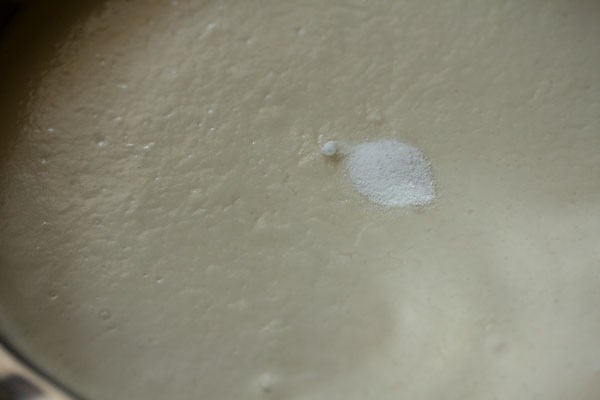
18. Mix the baking soda very well with the poha idli batter.
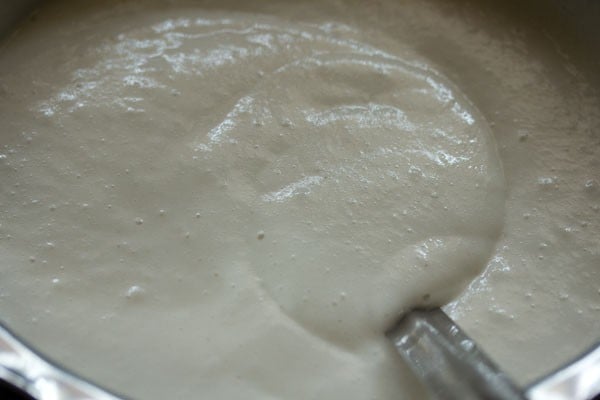
Steaming poha idli
19. Grease the idli moulds with oil. Pour the batter in the moulds.
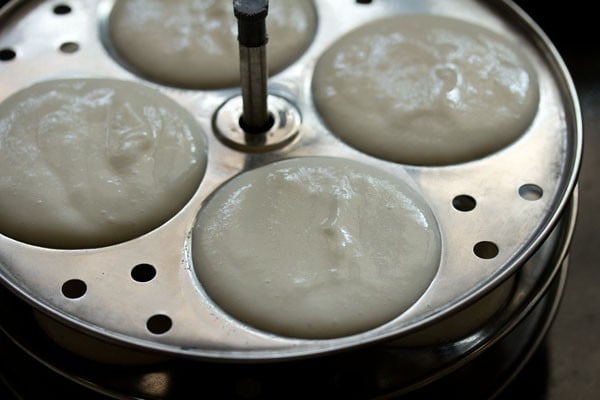
20. Before placing the idli stand, add 2 to 2.5 cups water in an electric cooker or steamer or pressure cooker. Bring this water to a boil. Then place the idli stand in the hot water.
For an electric cooker and steamer cover with its lid and steam. For pressure cooker, remove the vent weight/whistle from the cooker and secure the lid tightly on the cooker.
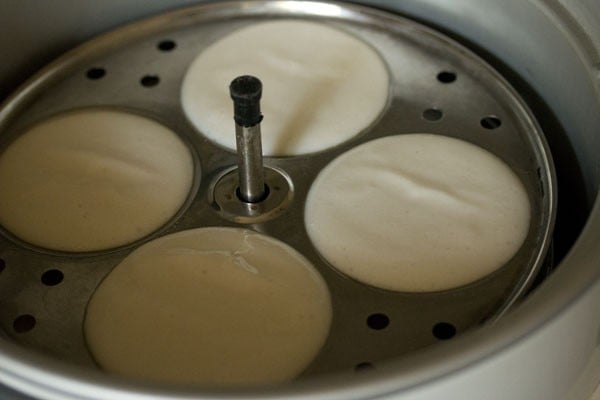
21. Steam aval idli for 12 to 15 minutes. Depending on the equipment you have used, it may take less or more time. A toothpick inserted in the center of the poha idli should come out clean and not be sticky.
Allow a standing time of 1 to 2 minutes. You can steam the idlis in batches. The leftover batter can be refrigerated and you can make paniyaram or sweet paniyaram from them. From this batter, dosa cannot be made.
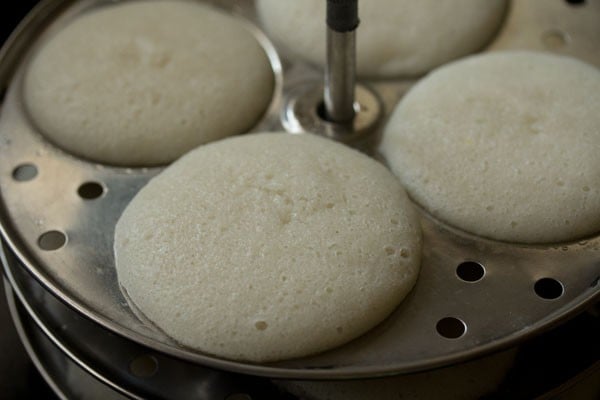
22. Dip a spoon or butter knife in water and slid them through the idlis. Remove and place the idlis in a warm container like a casserole.
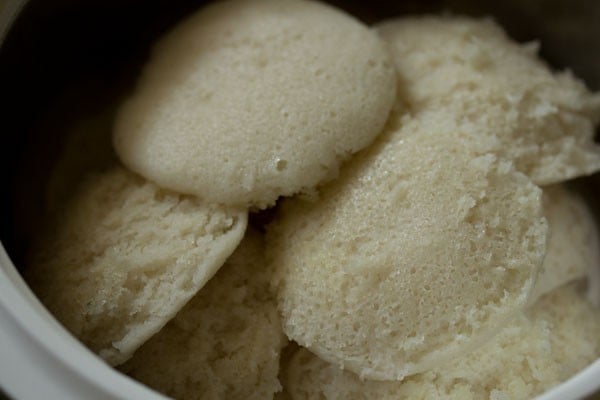
23. Serve poha idli hot with coconut chutney and idli sambar or with veg kurma.
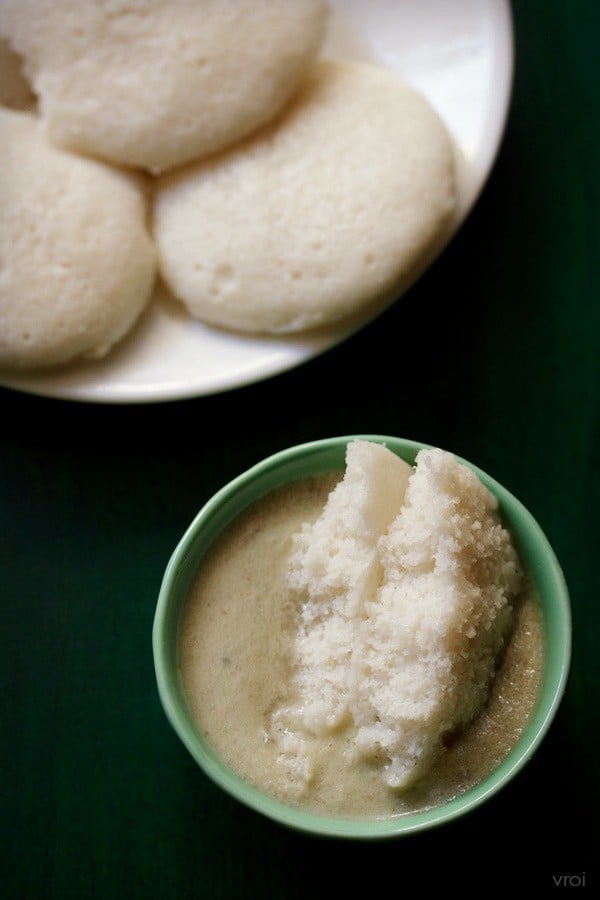
If you are looking for more Indian breakfast recipes then you may like:
Please be sure to rate the recipe in the recipe card or leave a comment below if you have made it. For more vegetarian inspirations, Sign Up for my emails or follow me on Instagram, Youtube, Facebook, Pinterest or Twitter.
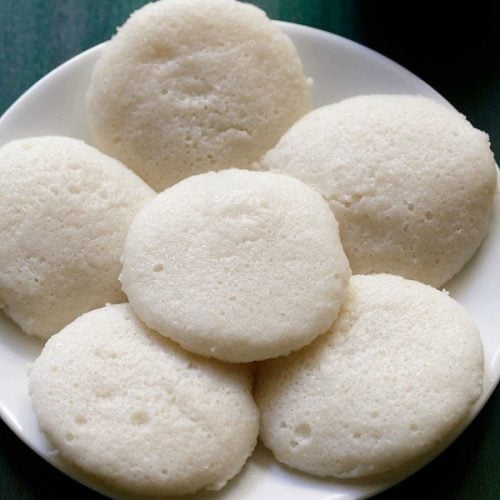
poha idli
Ingredients
- 1 cup idli dosa rice or parboiled rice or 200 grams idli dosa rice
- 1 cup thick poha or 80 grams thick poha (parched rice or aval)
- 3 tablespoon whole urad dal (husked whole black gram) or 40 grams whole urad dal (you can also use husked split urad dal),
- ¼ teaspoon methi seeds (fenugreek seeds)
- 2.5 cups water for soaking
- 1 cup water for grinding
- ½ teaspoon sugar (optional)
- ½ teaspoon rock salt (edible and food grade)
- 1/8 to ¼ teaspoon baking soda (optional)
- oil for greasing the idli moulds
Instructions
soaking
- In a bowl or pan, take the following ingredients – idli dosa rice or parboiled rice, whole urad dal, and 1/4 tsp fenugreek seeds.
- Rinse them for a couple of times and then soak in 2.5 cups water.
- In a separate bowl or pan, take the thick poha .
- Rinse the poha once or twice with water.
- Drain and add the poha to the bowl containing rice, urad dal, methi seeds and water.
- Mix well. Cover the pan and soak these four ingredients in water for 5 to 6 hours.
grinding poha idli batter
- Later strain and reserve the strained water.
- Now add half of the soaked ingredients in a wet grinder jar. Depending on the size of the jar, you can add half or full. I ground in two batches.
- Add 1/2 cup water and grind very well. The rice grains can have a consistency of that like idli rawa.
- Now pour the batter in a large bowl.
- I ground the batter in two batches and overall 1 cup water. If the grinder becomes hot, then wait for it to cool down and then continue with the grinder.
- Then add 1/2 tsp rock salt and 1/2 tsp sugar. Don’t worry the taste of sugar is not felt in the idlis.
- If you live in a hot or warm tropical climate, then no need to add sugar. Mix very well.
fermenting poha idli batter
- Cover the bowl with a lid and keep the bowl for 8 to 9 hours or more depending on the temperature conditions in your city.
- Add 1/8 tsp to 1/4 tsp baking soda and mix very well. This is optional. You can add baking soda if you want more softer idlis or if the batter has not fermented well.
making poha idli
- Grease the idli moulds with oil. Pour the batter in the moulds.
- Before placing the idli stand, add 2 to 2.5 cups water in an electric cooker or steamer or pressure cooker. Bring this water to a boil. Then place the idli stand in the hot water.
- For an electric cooker and steamer cover with its lid and steam. For pressure cooker, remove the vent weight/whistle from the cooker and secure the lid tightly on the cooker.
- Steam the idli for 12 to 15 minutes. Depending on the equipment you have used, it may takes less or more time.
- A tooth pick inserted in the center of the idlis should come out clean and not be sticky. Allow a standing time of 1 to 2 minutes.
- Dip a spoon or butter knife in water and slid them through the aval idlis. Remove and place the idli in a warm container like a casserole.
- Serve poha idli with coconut chutney and an onion sambar or mix veg sambar.
This Poha Idli post from the blog archives first published in December 2015 has been updated and republished on December 2022.
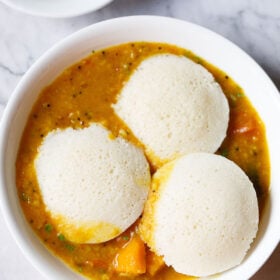
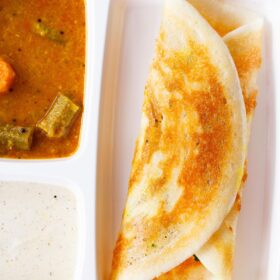
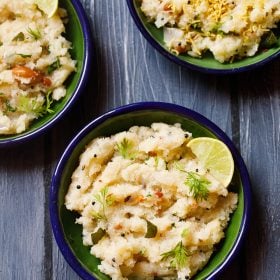
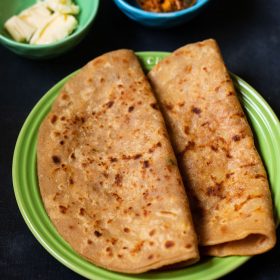








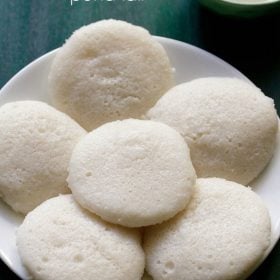
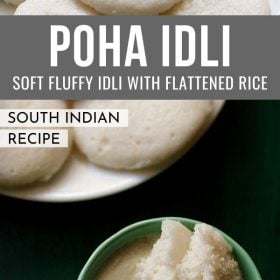
Hi I am a big fan of your recipes and I tried this recipe but it did not pan out very well. ..the dough ended up being chunky for some reason and the idlis tasted lumpy, even though I ground very well.
Can you guess what I may have done wrong? I used red aval and soaked it along with the rice.
Looks like the batter has not fermented properly. Poha makes for an incredibly soft idli. Both white aval and red aval work well. So my guess is that the batter did not ferment well. The batter has to increase in volume and you should see tiny air-pockets in it with a pleasant sour aroma. I hope this helps.
Hi,
Tried this..the idli was soft..but did not puff up..it was flat..please advise..thank you for this amazing recipe blog.
Welcome Deepa and thanks for the rating. When the idli batter is thin, the idli will become flat. The water consistency has to be right. If the batter is very thick, firstly the batter won’t ferment well and lead to dense idli. Thin batter will make flat thin idli. Next time you can reduce the water while grinding.
Hi Dassna,
I used your recipe recently but halved the amount of every ingredient. I live in a tropical country. The batter did not rise even after 12 hours. I did not add sugar, yeast or even baking soda as I am averse to all these ingredients. I kept the batter for another day. Still no luck. It was of liquid(watery) consistency. So decided to make dosa two days later. What could have gone wrong?
1. Is it necessary to soak all ingredients together or could I do it separately?
2. Your write up says 1:1( idli rice:poha) in cup version but in metric measurement it is 200g:80g. Care to elaborate the anomaly?
3. If I soak and grind them separately, which ingredient should be ground first? I am using a blender to grind by the way.
Thank you for your reply.
selvi, if the batter does not ferment well, most of the times it is due to a low room temperature. but since you mention you live in a tropical climate, the reasons for batter not fermenting would be the quality of water, batter not ground very well or less water in the batter.
1. you can soak the ingredients separately also.
2. 1:1 proportion is for cup measurement and not metric.
3. first grind the urad dal, methi seeds and poha. as the quantity of urad dal is less, so better to add poha and grind together. grind to a smooth batter. then remove in a bowl or pan. add rice and grind.
welcome and thanks.
Hi Dassna,
I tried my luck again yesterday. I soaked all the ingredients separately and ground them separately even before I saw your reply. Slight fermented smell but batter still did not rise like the normal idli rice recipe where the urad dal quantity is higher. The only reason why I fancy this poha idli recipe is because I need to cut down on legumes and lentils as my potassium level is borderline high. Therefore, this recipe is godsend but then again it is a high carbo recipe-rice flakes and idli rice-which hopefully does not spike up my sugar level. I love idlis- best for breakfast, lunch and dinner. I will try and try until I can get perfect this recipe and I get idlis like I see in your posted images. Thank you once again.
hi selvi, i am wondering what is going wrong with the fermentation. this poha idli batter ferments but there will be a slight rise. i forgot to mention this point in my last reply. the batter won’t double or triple like the regular idli batter. and this is the reason that baking soda is added to the batter.
an alternative for you is to add 1/4th teaspoon yeast (instant yeast). dissolve instant yeast in 2 to 3 tablespoons water and then add this solution to the idli batter after the batter is fermented. mix well. cover and keep it aside at room temperature for 30 to 45 minutes. the batter will get the tiny air pockets and become fluffy. then make idlis. the downside of this method is that you will need to use the entire batter in one go. even if you keep in the fridge, the batter will keep on leavening and get a yeasty aroma and taste. an option here is to freeze the batter and use it later.
with regards to your health considerations, you have a look at below two idli recipes made with foxtail millet and okra which i have already shared on the blog.
Hi dassana,
I ground this batter last night and kept it for fermentation till tonight. I also added sugar in the batter to help the process.
But due to cold weather+rains, it didn’t rise much. There were small bubbles and yeasty smell though. I added salt and made first batch.
But the idling came out a bit too dense. I have made triple amount batter.
Is there something I can do to improve the remaining batch?
Also should I keep the batter outside the fridge till it gets over?
ruchi, the batter has not fermented well due to the cold climate. keep the batter in a warm place or near a heater. you also keep in sunlight if you get some sun during the day. just keep for some hours, like 3 to 4 hours. or you can heat an oven at 80 to 90 degrees celsius for 15 minutes. then switch off oven and keep the idli batter in it for some hours. or if your oven has lights, then lit the oven and keep the batter in it. for a lit oven no need to preheat the oven.
Thank you for responding.
You were right, it hadn’t fermented well. I kept it for one more full night & it rose very well. The idlis came out perfect then.
But there was one thing.. the idlis had some orange streaks/spots. Do you have any idea what caused that? There was no issue in tast & texture.
Also, if I plan to ferment one more batch, can I pour the new batch of batter in the same container? I just finished making idlis with the last batter. There is residual batter sticking in the bowl. So I was thinking if pouring in the same bowl will speed up the next fermentation (like in curd)?
welcome ruchi. i guess the spots are due to bacterial fermentation. this happened with me while fermenting curd. if the taste and smell is not off or weird, then the batter should be fine to use.
of course, you can use the same container. it will speed up the process. even a spoon of leftover batter can be freezed or refrigerated and added to fresh batter. it helps in fermentation and speeds it up, especially in cold climates. since the bacteria culture is present in the leftover batter. this method can also be used while fermenting bread dough.
Dear DAssana
this is Arusha ….u have replied to my querry in khatta dhokla.
u have mentioned about cold temperature. I have question there but cant write on this open box. do u have email id? I can write there.
or WhatsApp?
arusha, i have received your email. i will reply you shortly.
Hi Dassana
Good morning !
I tried this one this time and had trouble making these too, i cant figure out what and where i have been wrong in the process..also the idli texture has come out very unexpected i have taken pictures, if you dont mind can i share them with you if you could provide me your email address or anywhere where i could share them. As i have prepared this batter in large quantity which i usually and dont want it to get wasted.
Thank you
Samrinder
samrinder, you can send me the images on my email id shared in the about page.
after seeing the pics, i can tell what must have gone wrong.
Hi dassana, I’v tried this recipe many times by now and idlis always turn out amazing. There’s just a little glitch that i face every time- that the idlis come out a little denser than the ones shown in your pic. I’m listing out some things that I do:
1. I use khichari rice since I don’t get idli rice here (i thought basmati rice would be a bit ‘hard’ for idli)
2. I uncover the lid of steamer immediately after 10-12 min of steaming to avoid water droplet formation over idlis.
3. i prepare triple amount of batter and refrigerate it after fermentation. i use it over period of 3-4 days. Idlis turn out more dense on later days i’ve noticed
Though the taste and aroma of idlis always turns out perfect, it is just the texture that i want to improve. Thanks
ruchi, everything is fine. just add some more water to the batter. if less water is added, then the idlis turn out dense. the water ratio is important.
Hi…ur website is a great help to novices like me. Thank you so much. Just wanted to know can I make set dosa from this batter if it becomes too watery for idli?
thanks shilpa. for set dosa, the dosa has to be smaller in size and slightly thick. when cooking, cover the dosa with a lid. usually set dosas are cooked only one side.
Hi mam,
I have tired many of ur recipes..thy had come out really well.. 🙂
I’m planning to prepare poha idly, I dont have a wet grinder, can the same ingredients make idlis soft if going in mixer.
Please reply
Thanks Pavitra hebbar
thanks pavitra. you can grind the batter easily in a mixer. but grind in batches and stop for some minutes in case the mixer becomes too hot.
Hi dassana,
Can we keep the idli batter out in the sunlight to make it ferment?
you can ruchi. i also keep it during winters.
yes I kept it in the sun today and it was fermented by the evening! Just had a idli-sambar dinner 🙂 it was the first time we made idlis at home. Everybody kept raving about the light & soft idlis. Thank you for sharing all the amazing recipes!
thats great ruchi. with poha the idlis become amazingly soft and light. most welcome ?
Hello, very nice recepie, would like to know that if we use idli rawa instead of idli rice then that is also need to soak with urad da,pohal and me hi seeds for 5-6 hrs before grinding?
apeksha, if you use idli rava, then soak it separately for 4 to 5 hours. you can soak the urad dal, poha and methi seeds separately in another bowl. then drain the idli rava very well and then grind separately. do note grinding idli rava is optional. you can just grind urad dal, poha and methi seeds and then mix it with the strained idli rava.
Can i use thin poha for this recipe?
neelam, you can use thin poha.
Idlis turned out soft cotton like…very nice n tasty…?
thanks divya for the feedback 🙂
Hi..mam i am a big fan of ur blog. Its jst great. Ur recipes r vry simple. N those pictures of help me in cooking perfectly. I hve tried many dishes like momos, egg less chocolate, rava idli n many more. Thank u so much.
I hve a request cn u suggest sumthing interest to make i appam maker. I tried to make muffin in that bt sumhow ig did nt cme out properly.
thank you sushree. you can make scones or danish pancakes. you can even make muffins, but just make sure that the muffin batter is well aerated. and cook them on a low flame. you can cover and cook them.
Can I use suji instead of idli rawa?
As I am unable to get idli rice or rice rawa.
Plz help me.
then use rice. you can use sona masuri rice or parimal rice. with rava the taste as well as the texture will change.
hi Dassana,
have tried many recipes from your site. this is my favourite blog. all that I have tried have turned out well. thanks a tonne for creating such a wonderful platform with great, authentic and well tried out recipes.
very pleased to know this veena, thanks for positive feedback and encouraging words.
Can I use idli rava instead of idli rice?
you can use idli rava. use the same amount which is 1 cup.
The idli receipe is amazing…softest idlis ever ..
However my batter turned out a lil runny ..is there any way one can re adjust the consistency of the runny batter
thank ronz for the feedback. just add some idli rava (if you have it) or add some sooji/rava (cream of wheat or farina). another option is to add some rice flour.
Hi,
Can I use the flat poha and what difference would it make.
connie, by flat poha you mean thin poha. if yes then you can use flat poha (thin poha). texture might be less soft, but i am not sure. because i always use thick poha.
Hi, I tried this poha idli and when I steamed it, it fell apart and there was no idlis formed, the batter splattered all over the pot after 10 mins
What do I do ?
looks like the batter was very thin. add some rice flour to thicken the batter and make the dosas. another reason could be that while steaming, there was too much water in the pan or cooker. the water should not touch the idli moulds.
Hi
Thanks for your immediate and kind response. I went ahead with a trial of making frozen idly. Just froze 4 and steamed them again for about 10 minutes I should say it wasn’t bad although not as tasty as the fresh ones but was soft. I am not yet sure about the shelf life so will try again and use it after 10-15 days later. Will get back after that experiment .
welcome bhuvana. thanks for sharing your method. i agree that the taste will not be like that of fresh idlis, but will be fine to have. you will get some ideas while experimenting. all the best 🙂
Hi
I live in Brussels and will be travelling to India during the summer vacations for about 6 weeks .We get frozen parathas but not frozen idly. Can you please guide me to make frozen idly? And also about the shelf life of it? I can travel in peace without worrying much about my husband skipping his breakfast. Please help.
hi bhuvana, i don’t think frozen idlis will taste as good as fresh idlis. i do not know how frozen idli is made. so unable to help you.
Hi…please tell me…Can we use idli rava instead of rice? And what will be the soaking time? TIA
yes you can use idli rava. just soak it for about 4 to 5 hours.
Hello, I am kavitha,.. Yesterday tried cheese chilli toast…it came out good..thanks for the recipe..
pleased to know this thankyou so much kavitha 🙂
Thank you so much for sharing your delicious recipes with us! Have tried out many recipes of yours. You make them so simple and straightforward. The poha idli came out super soft. The tip of adding sugar first for fermentation and salt only later on is really effective. Looking forward to trying out even more of your lovely dishes.
firstly a big thankyou for your kind and honest words. surely try more recipes and keep us posted how it was? god bless you.
Thanks for posting about breakfast recipes .really useful.
thankyou so much daniel 🙂
I tried poha idli today.it came out so soft ,light n excellent taste .it is very easy to prepare n no tension for the result.thank u !!
thanks hema for the feedback. glad to know.
V nicely explained.
thanks.
Thank you for your advice regarding fermenting batter in a cold climate. I live in the UK and my kitchen is always cold and even warming the oven does not do the trick. I will try the sugar, and if necessary, the baking soda. Your site is very helpful.
thanks jane. both the sugar and baking soda tips works. here in india, where i live now its 16 degrees celsius and in the night the temperature drops to 11 or 12 degrees celsius. not as cold as UK, but even in this temperature the batter does not ferment well, when i do not add sugar. when i add sugar, the batter rises well and ferments also well. just yesterday night, i made dosa batter to which a bit of sugar was added and it fermented beautifully in the morning. you can also keep the batter bowl near a light source eg a reading light. the warmth from the light also helps.
Hi Mam ,, love your blog… Learnt north Indian recipes from urs..
We ppl in south generally don’t use rock salt for idli or dosa batter is it necessary for the soft texture.
generally iodized salt comes in way of the fermentation process, which does not happen when we use rock salt. not only for making idli and dosa, but i use rock salt in all my cooking.
Hai i have already soaked the ingredients. Can you please suggest me is there any extra care or step to be taken if I am grinding in the mixer.
Thank you
nanditha, just grind in parts (2 or 3 parts) and if the mixer becomes hot, then stop grinding. let the mixer cool down and grind again. add water as required while grinding. in case the batter becomes thin, then just add some rice flour to thicken the batter slightly.
Hello mam,
I made this idli today for breakfast. It was to good, soo soft, N tasty also……
I have one request, can u pls post the recipe of methi laddu and ragi laddu.I want to make this laddu for my mom, she like this very much…
So pls….
thanks suvidha for trying the recipe. agree they are so soft. i have taken the recipe requests on file and will try to add them.
Thanku mam……?
welcome suvidha 🙂